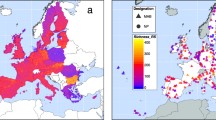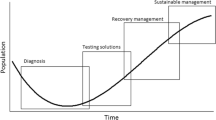Abstract
We have examined the distribution of 26 species of steppe birds in the Iberian Peninsula and the Balearic Islands within a grid of 5,070 10 × 10 km grid cells. The most valuable areas for steppe birds have been identified by selecting the upper 5% of the 10 × 10 km grid cells after a simple ranking based on the following criteria: species-richness, richness of rare species, rarity index, species vulnerability at Spanish, European and Global levels, and using an index combining the previous criteria. We have also used a heuristic algorithm to select those areas which offered most complementarity. The results have been analysed on a national scale and have been compared with those obtained by species assessments in previous status summaries. Finally, we have performed an analysis of the coverage afforded to locations which are valuable for steppe species by Natural Protected Areas (NPAs) and Special Protected Areas (SPAs), and an evaluation of the potential effects of temporal changes in species’ threat-status.
The combined index was the most reliable criterion for defining hotspots, encompassing 15% of the species’ distributions within 5% of the total area considered. This index showed a high level of geographical concordance with the other criteria (nearly 70% of the selected grid cells coincided). Analysis of complementarity delivered poorer results than simple rank-scoring. The analysis of the efficiency of NPA network showed a very low coverage (less than 2%) of the hotspots selected according to the Combined Index. Coverage of the SPA network was higher (nearly 45%), although it diminished (to <35%) when only steppe-defined SPAs were included. The geographical concordance between high-value areas selected using current status summaries and those chosen using earlier ones was low for European threat status (53.4%), intermediate (63.2%) for Spanish threat status and high for SPEC status (78.1%). The Combined Index showed a high level of geographical concordance between the old and new data (76.6%). We conclude that automatic scoring methods (identifying hotspots) are useful for selecting valuable areas and for analysing the efficiency of the network of protected natural spaces, as well as for examining the potential effects of status changes on hotspot definition. Furthermore, the Spanish SPA network does not cover the most important areas for steppe birds adequately.




Similar content being viewed by others
References
Abellán P, Sánchez-Fernández D, Velasco J, Millán A (2005) Conservation of freshwater biodiversity: a comparison of different area selection methods. Biodiv Conserv 14:3457–3474
Andelman SJ, Fagan WF (2000) Umbrellas and flagships: efficient conservation surrogates or expensive mistakes? Proc Nat Acad Sci 97:5954–5959
Araújo MB, Williams PH (2001) The bias of complementarity hotspots towards marginal populations. Cons Biol 15:1710–1720
Arponen A, Heikkinen RK, Thomas CD, Moilanen A (2005) The value of biodiversity in reserve selection: representation, species weighting, and benefit functions. Cons Biol 19:2009–2014
BirdLife International (2004) Birds in Europe Population estimates, trends and conservation status. Bird Conservation Series No. 12. BirdLife International, Cambridge
Blanco JC, González JL (eds) (1992) Libro Rojo de los vertebrados de España. ICONA-MAPA, Madrid
Burfield I (2005) The conservation status of steppic birds in Europe. In: Bota G, Morales MB, Mañosa S, Camprodon J (eds) Ecology and conservation of steppe-land birds. Lynx Editions, Barcelona, pp 119–140
Burgess N, Küper W, Mutke J, Brown J, Westaway S, Turpie S, Meshack C, Taplin J, Lovett JC (2005) Major gaps in the distribution of protected areas for threatened and narrow range Afrotropical plants. Biodivers Cons 14:1877–1894
Bustamante J (1997) Predictive models for lesser kestrel Falco naumanni distribution, abundance and extinction in southern Spain. Biol Cons 80:153–160
ESRI (2000) ArcGis version 9.1. Redlands, CA
Faith DP, Walker PA (1996) Integrating conservation development: incorporating vulnerability into biodiversity assessment of areas. Biodivers Cons 5:417–429
Garson J, Aggarwal A, Sarkar S (2002) ResNet Manual, ver. 1.2. University of Texas at Austin, Austin
Hoctor TS, Carr MH, Zwick PD (2000) Identifying a linked reserve system using a regional landscape approach: the Florida ecological network. Cons Biol 14:984–1000
IUCN (2001) IUCN Red List Categories and Criteria: Version 3.1. IUCN Species Survival Commission. IUCN, Gland and Cambridge
Jiguet F, Julliard R, Couvet D, Petiau A (2005) Modelling spatial trends bird survey data: a valuable tool in biodiversity assessment. Biodivers Cons 14:3305–3324
Kati V, Devillers P, Dufrêne M, Legakis A, Vokou D, Lebrun P (2004) Hotspots, complementarity or representativeness? Designing optimal small-scale reserves for biodiversity conservation. Biol Cons 120:471–480
Kelley C, Garson J, Aggarwal A, Sarkar S (2002) Place prioritization for biodiversity reserve network design: a comparison of the SITES and ResNet software packages for coverage and efficiency. Divers Distrib 8:297–306
Kerr JT (1997) Species richness, endemism, and the choice of areas for conservation. Cons Biol 11:1094–1100
Lawton JH, Prendergast JR, Eversham BC (1994) The numbers and spatial distributions of species: analyses of British data. In: Forey PL, Humphries CJ, Vane-Wright RI (eds) Systematics and conservation evaluation. Clarendon Press, Oxford, pp 177–195
Madroño A, González C, Atienza JC (eds) (2004) Libro rojo de las aves de España. Dirección General de la Naturaleza-SEO/BirdLife, Madrid
Margules CR, Pressey RL (2000) Systematic conservation planning. Nature 405:243–253
Margules CR, Nicholls AO, Pressey RL (1988) Selecting networks of reserves to maximize biological diversity. Biol Cons 43:63–76
Martí R, del Moral JC (eds) (2003) Atlas de las Aves Nidificantes de España. Dirección General de la Naturaleza-SEO/BirdLife, Madrid
Morales MB, Suárez F, García de la Morena EL (2006) Reponses des oiseaux de steppe aux differents niveaux de mise en culture et d’intensification du paysage agricole: une analyse comparative de leurs effets sur la densite de population et la selection de l’habitat chez l’outarde canepetiere Tetrax tetrax et l’outarde barbue Otis tarda. Rev d’Ecol (Terre et Vie) 61:261–270
Myers N (1988) Threatened biotas: “Hot Spots” in tropical forests. Environmentalist 8:187–208
Myers N, Mittermeier RA, Mittermeier CG, da Fonseca GAB, Kent J (2000) Biodiversity hotspots for conservation priorities. Nature 403:853–858
Negro JJ (1997) Lesser kestrel. BWP Update 1:40–56
Prendergast J, Quinn RM, Lawton JH, Eversham BC, Gibbons DW (1993a) Rare species, the coincidence of diversity hotspots and conservation strategies. Nature 365:335–337
Prendergast J, Wood SN, Lawton JH, Eversham BC (1993b) Correcting for variation in recording effort in analyses of diversity hotspots. Biodiv Lett 1:39–53
Pressey RL, Tully SL (1994) The cost of ad hoc reservation: a case study in the Western Division of South Wales. Aust J Ecol 19:375–384
Pressey RL, Possingham HP, Day JR (1997) Effectiveness of alternative heuristic algorithms for identifying indicative minimum requirements for conservation reserves. Biol Cons 80:207–219
Ramírez A (2004) Efectos geográficos, ambientales y biológicos sobre la distribución de las aves forestales ibéricas. Ph.D. Thesis. Universidad Complutense de Madrid, Madrid
Rey Benayas JM, de la Montaña E (2003) Identifying areas of high-value vertebrate diversity for strengthening conservation. Biol Cons 114:357–370
Santos T, Suárez F (2005) Biogeography and population trends of iberian steppe bird. In: Bota G, Morales MB, Mañosa S, Camprodon J (eds) Ecology and conservation of steppe-land birds. Lynx Edicions, Barcelona, pp 69–102
Sarkar S, Arrarwal A, Garson J, Margules CR, Zeidler J (2002) Place prioritization for biodiversity content. J Biosci 27:339–346
Scott JM, Davis F, Csuti B, Noss R, Butterfield B, Groves C, Anderson H, Caicco S, D’Erchia F, Edwards TC, Ulliman J, Wright G (1993) Gap analysis: a geographic approach to protection of biological diversity. Wildl Monogr 123
Sólymos P, Fehér Z (2005) Conservation prioritization based on distribution of land snails in Hungary. Cons Biol 19:1084–1094
Snow DW, Perrins CM (1998) The birds of the western Paleartic. Oxford University Press, Oxford
Suárez, F, Sainz H, Santos T, González-Bernáldez F (1992) Las estepas Ibéricas. Ministerio de Obras Públicas y Transportes, Madrid
Suárez F, Naveso MA, De Juana E (1997) Farming in the drylands of Spain: birds of pseudosteppes. In: Pain DJ, Pienkowski NW (eds) Farming and birds in Europe. The common agricultural policy and its implications for bird conservation. Academic Press, San Diego, pp 79–116
Suárez F, Garza V, Morales MB (2003a) Skylark Alauda arvensis densities and habitat selection in Mediterranean Iberia: the role of shrub-steppes and extensive dry-pastures. AGEE 95:551–557
Suárez F, Traba J, Morales MB, Arrieta S, Herranz J, Oñate JJ (2003b) Aves y evaluación de impacto ambiental: ¿ estamos identificando el problema correctamente? Ardeola 50:295–300
Suarez-Seoane S, Osborne PE, Baudry J (2002) Responses of birds of different biogeographic origins and habitat requirements to agricultural land abandonment in northern Spain. Biol Cons 105:333–344
Tucker GM, Heath MF (1994) Birds in Europe: their conservation status. Bird Conservation Series No. 3. BirdLife International, Cambridge
Vane-Wright RI, Humphries CJ, Williams PH (1991) What to protect? Systematics and the agony of choice. Biol Cons 55:235–254
Williams P, Gibbons D, Margules C, Rebelo A, Humphries C, Pressey R (1996) A comparison of richness hotspots, rarity hotspots, and complementary areas for conserving diversity of British birds. Cons Biol 10:155–174
Author information
Authors and Affiliations
Corresponding author
Appendix
Appendix
Rights and permissions
About this article
Cite this article
Traba, J., García de la Morena, E.L., Morales, M.B. et al. Determining high value areas for steppe birds in Spain: hot spots, complementarity and the efficiency of protected areas. Biodivers Conserv 16, 3255–3275 (2007). https://doi.org/10.1007/s10531-006-9138-2
Received:
Accepted:
Published:
Issue Date:
DOI: https://doi.org/10.1007/s10531-006-9138-2




